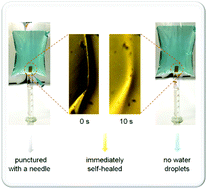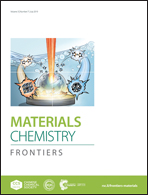An ultrafast self-healing polydimethylsiloxane elastomer with persistent sealing performance†
Abstract
Silicone waterproofing sealants are susceptible to either rupture or scratches due to their low scratch resistance, leading to reduced sealing performance. Herein, an ultrafast self-healing polydimethylsiloxane elastomer is developed to solve this problem. The novel polydimethylsiloxane elastomer, obtained by crosslinking a long chain of poly(dimethylsiloxane) with a tetra-functional biphenyl unit via an aldimine polycondensation reaction, exhibits ultrafast self-healing properties (can be efficiently healed at room temperature within 60 s) although it is quite tough and strong (with Young's modulus of 120.6 ± 8.2 kPa, elongation >8000%, and adhesive stress values of 30–700 kPa for various substrates). As demonstrated by water absorption tests and self-designed water bag experiments, this new polymer can completely self-heal punctured holes or scratches in seconds and therefore maintain its excellent sealing property. This unique material will have wide commercial applications not only as a sealant, but also in many other industrial fields, including electrochemical sensors, wearable electronics, and biomedical adhesives.



 Please wait while we load your content...
Please wait while we load your content...